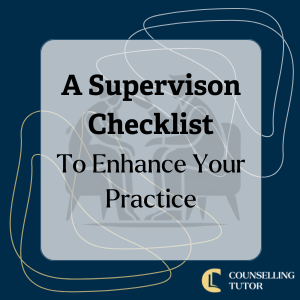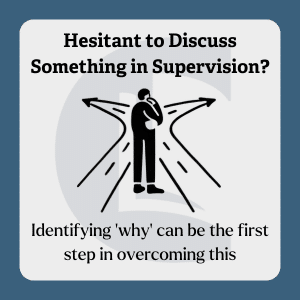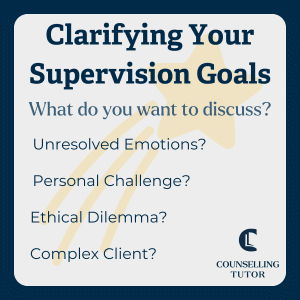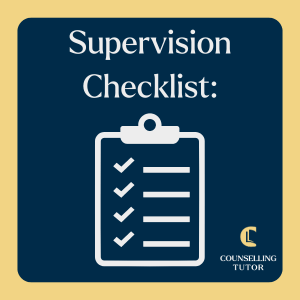Including Online and Telephone Working
Certificate in Clinical Supervision
Become a Skilled, Ethical & Confident Clinical Supervisor with the tools and knowledge to supervise effectively across all platforms.
If you’re interested in becoming a Supervisor, have a look at our Certificate in Clinical Supervision Including Online and Telephone Working.

Become a Skilled, Ethical & Confident Clinical Supervisor with the tools and knowledge to supervise effectively across all platforms.
Supervision is a cornerstone of ethical and effective counselling and psychotherapy practice. It safeguards clients and provides a vital space for therapists to explore challenges, enhance their skills, and maintain their well-being.
This article introduces a structured supervision checklist for therapists designed to help them prepare, reflect, and maximise the benefits of their supervision sessions.

A Supervision Checklist for Therapists
By the end of this article, you will:
Before attending a supervision session, take a moment to identify what you want to discuss and why. This clarity can help focus the session and help you use your time best.


Supervision should be a safe space for honest conversations, but fears or uncertainties can sometimes hold us back.
Your goals for supervision might vary session by session. Pinpoint what you aim to achieve:

Supervision is a vital space for addressing the emotional impact of your work. Whether you are dealing with sadness, frustration, or burnout, use supervision to process these emotions and prevent them from affecting your client relationships or overall well-being.
The ultimate goal of supervision is to improve client outcomes. By addressing your needs, gaining new perspectives, and building skills, you can ensure the highest standard of care. Remember that this space is designed to support you and your clients.
Below is a practical supervision checklist summarising the key points. This format is designed to be easily referenced and implemented in your practice.
| Category | Questions to Reflect On | Actions to Consider |
| Setting Intentions | – What specific cases or challenges do you need to discuss? | – Identify key issues before the session. |
| – Are there clients whose situations feel resolved? Why do you feel they don’t need further exploration? | – Reflect on whether these cases could offer additional insights. | |
| – Do you need clinical notes to aid memory or enhance discussions? | – Bring notes to focus the session and recall key details. | |
| Barriers to Discussion | – Are there topics you feel hesitant or afraid to discuss? Why? | – Identify and confront the reasons for avoidance. |
| – Are there clients you don’t feel the need to discuss? | – Explore whether these clients might reveal overlooked aspects of your practice. | |
| – Are you feeling stuck or de-skilled with a particular client? | – Use supervision to brainstorm new approaches and strategies. | |
| Supervision Goals | – Are you navigating an ethical dilemma? | – Clarify the ethical issue and discuss it with your supervisor for guidance. |
| – Are personal challenges (e.g., transference, countertransference, parallel processes) affecting your practice? | – Reflect on personal influences and their potential impact on therapeutic relationships. | |
| – Are you emotionally impacted by client interactions or endings? | – Seek emotional support to process feelings of sadness, frustration, or burnout. | |
| Enhancing Client Care | – Are there ways to enhance your practice based on supervision insights? | – Apply feedback and perspectives gained in supervision to improve client outcomes. |
| – How can this session support both you and your clients? | – Focus on aligning your professional development with client needs. |

A Supervision Checklist for Therapists
Before supervision, identify specific client cases or professional challenges you want to discuss, bring relevant clinical notes, and reflect on cases you consider “resolved” to see if they still offer learning points.
Notice any topics you feel afraid or hesitant to bring up, explore why you avoid certain client or practice issues, and use supervision as a space to address feeling stuck or de‐skilled with clients.
Set goals around ethical dilemmas (like transference or countertransference), emotional effects of work (loss, burnout), personal influences on practice, and always aim to align professional growth with better client outcomes.
Effective supervision relies on thorough preparation, self-reflection, and active engagement. You can make the most of each session by carefully considering your needs, addressing any challenges, and establishing clear, actionable goals.
Using the supervision checklist as a practical guide ensures a structured approach to these efforts. It helps you explore key areas, overcome potential barriers, and enhance your practice. This deliberate process supports your professional growth and ensures that your clients receive the highest standard of care.
Counselling Tutor provides trusted resources for counselling students and qualified practitioners. Our expert-led articles, study guides, and CPD resources are designed to support your growth, confidence, and professional development.
👉 Meet the team behind Counselling Tutor
Notice any broken link or issues with this resource? Kindly let us know by email
Email us